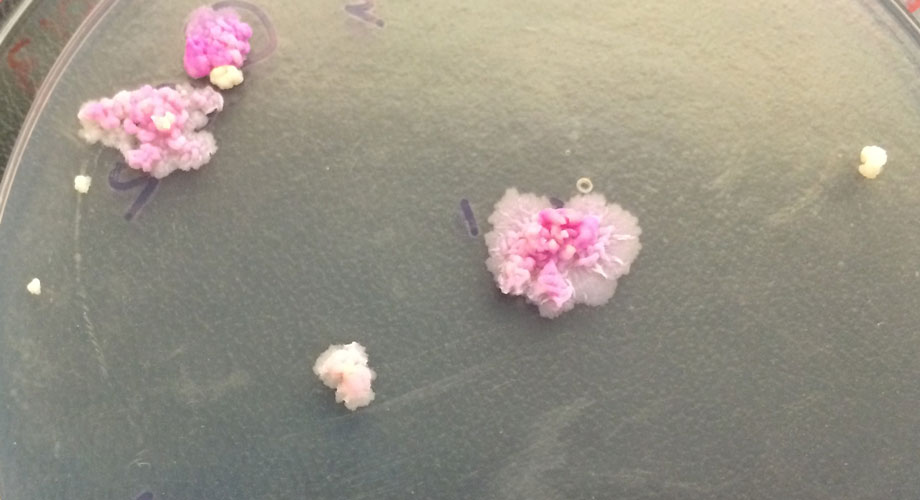
Colonies of Mycobacterium tuberculosis, the bacterium responsible for tuberculosis. Credit: Paridhi Sukheja, Calibr-Skaggs
Researchers identify promising new compound to treat tuberculosis
Study led by Scripps Research, Texas A&M and additional institutions highlights that the world’s deadliest infectious disease needs novel, effective antibiotics.
August 07, 2025
LA JOLLA, CA—Scientists have developed a new compound that could offer a breakthrough in the global fight against tuberculosis, history’s deadliest infectious disease.
A study recently published in Nature on July 30, 2025, describes the treatment potential of the novel compound known as CMX410. The drug uniquely targets a crucial enzyme in Mycobacterium tuberculosis, the bacterium responsible for tuberculosis. Importantly, this compound even proved effective against drug-resistant infections, which are common globally and pose a significant challenge for controlling the disease’s spread and progression.
The study was led by James Sacchettini, Ph.D., the Rodger J. Wolfe-Welch Foundation Chair in Science, Texas A&M AgriLife Research scientist and professor in the Texas A&M College of Agriculture and Life Sciences Department of Biochemistry and Biophysics. He was joined by Case McNamara, Ph.D., senior director of infectious disease at Calibr-Skaggs Institute for Innovative Medicines, the nonprofit drug development division of Scripps Research dedicated to accelerating next-generation medicines.
The discovery was made possible through collaborations formed by the TB Drug Accelerator program, an initiative funded by The Gates Foundation to support research focused on developing the most promising tuberculosis treatments.
“A lot of people think of tuberculosis as a disease of the past,” Sacchettini said. “But in reality, it remains a major public health issue requiring significant attention, collaboration and innovation to overcome.”
A smarter way to fight back
The new compound identified by AgriLife Research and Calibr-Skaggs works by blocking a crucial enzyme, polyketide synthase 13 or Pks13, that M. tuberculosis needs to build its protective cell wall. Without the functionality of this protein, the bacteria can’t survive to cause infection.
For over a decade, scientists have recognized this protein as a high-value target in the fight against tuberculosis. Yet, despite its potential, drug development efforts have repeatedly fallen short — largely because compounds must clear a high bar for both safety and therapeutic performance.
The unique mechanism of CMX410 makes it highly specific for its target, which translates to a favorable safety profile. By incorporating a reactive chemical group that forms an irreversible bond with a critical site on Pks13, the researchers enhanced the compound’s selectivity, minimizing potentially negative off-target effects. This modification also reduces the likelihood of resistance emerging.
The addition of this key chemical group was accomplished with click chemistry, a method that snaps molecules together like puzzle pieces. Click chemistry was developed by co-author Barry Sharpless, Ph.D., W.M. Keck Professor of Chemistry at Scripps Research and two-time Nobel Laureate, and it has led to the development of extensive libraries of chemical compounds.
“This technique represents a new tool for drug design,” said McNamara. “We expect to see its uses expand in the coming years to help address public health concerns with a critical need, including tuberculosis.”
Early results prove safe and effective
The team began by investigating a library of compounds shared by the Sharpless lab to identify molecules that could inhibit bacterial growth of M. tuberculosis.
After intensive optimization to improve compound potency and other pharmacological properties led by Calibr-Skaggs tuberculosis team members and co-first authors Baiyuan Yang, Ph.D., associate director of medicinal chemistry, and Paridhi Sukheja, Ph.D., investigator of infectious diseases, CMX410 was identified as a strong contender.
Yang, who led the chemistry optimization, said the team explored more than 300 analogs to identify a compound with the right balance of potency, selectivity and safety. The team ultimately tested CMX410 against 66 strains of M. tuberculosis and found that it worked on both laboratory and multidrug-resistant strains collected from real patients.
“Identifying this novel target was an exciting moment,” said Sukheja, who led many early studies showing CMX410 could target a previously unexplored gene. “It opened up a completely new path forward, especially against strains that have learned to evade existing treatments.”
In other early experiments, the researchers determined that CMX410 could be safely combined with other tuberculosis antibiotics. This was an especially important factor for this disease, as treatment regimens require multiple drugs to be taken together for months at a time.
Researchers found no adverse effects in their initial tests in animal models even at the maximum dose level. And because CMX410 is highly specific to its target protein, they see it as unlikely to disrupt other beneficial bacteria or cause broader microbiome imbalances, a common side effect of conventional antibiotics.
Progress toward better treatments
The addition of a specialized chemical group that allows CMX410 to irreversibly bind to its target makes the compound extremely selective. These types of inhibitors remain an exciting and underexplored class of drugs, and further research will be needed to confirm their safety for humans.
Nonetheless, the precision, unique mechanism, good safety profile and other key features all make CMX410 a promising candidate for treating tuberculosis.
“These early results are very encouraging,” said Inna Krieger, Ph.D., senior research scientist in Sacchettini’s lab and co-first author of the study. “Cell wall-targeting antibiotics have long been a cornerstone of tuberculosis treatment. However, after decades of widespread use, their effectiveness is waning due to the rise of drug-resistant strains.
“We are working to discover new drugs that disrupt essential biological processes and identify optimal combinations with existing drugs to enable shorter, safer and more effective treatment regimens. Through these efforts, we hope to help move the world closer to a future free from tuberculosis.”
For more information, contact press@scripps.edu

